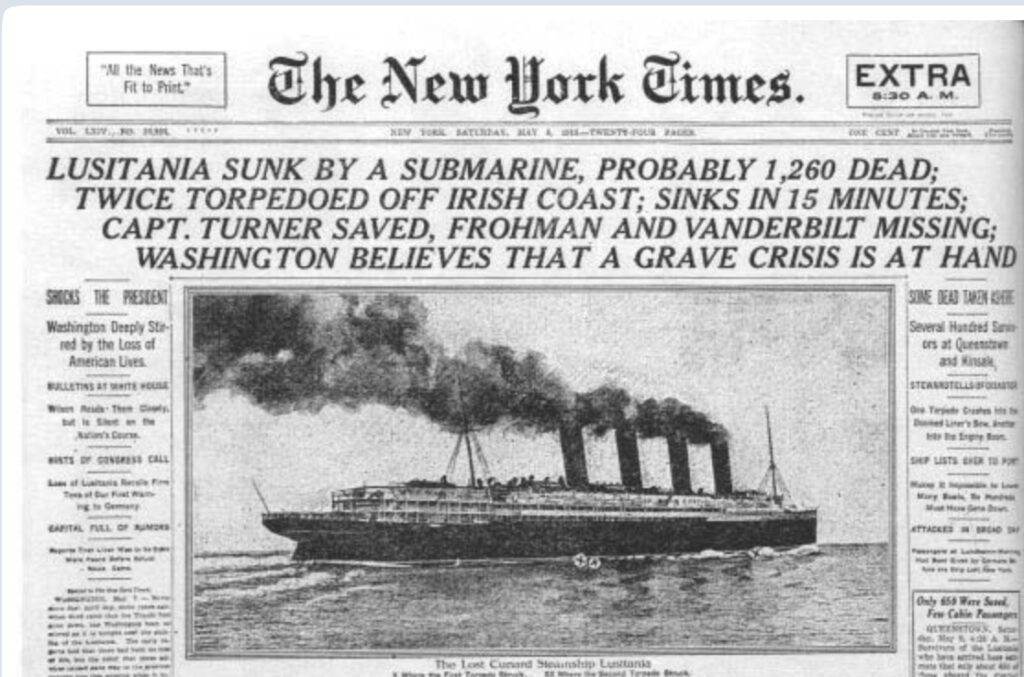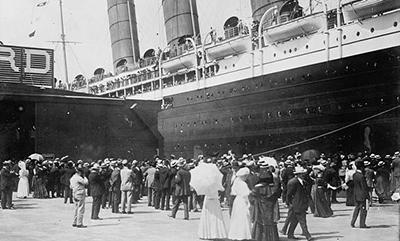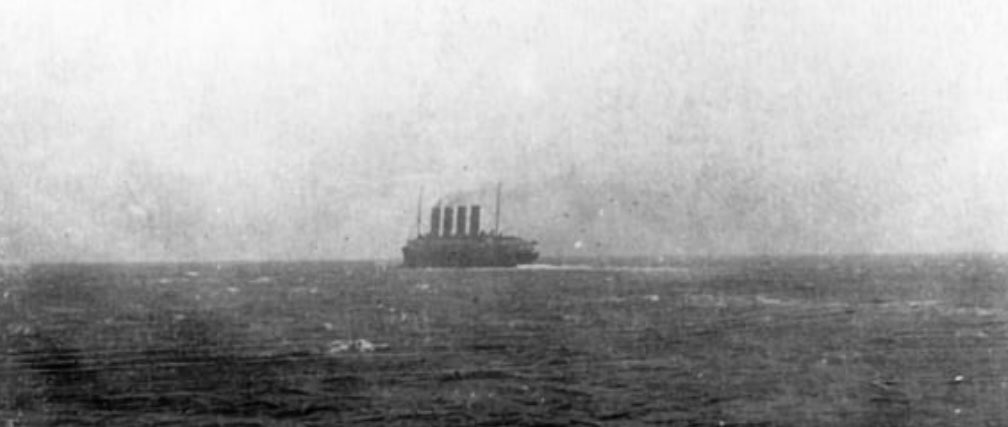One of the most terrible and major incidents of World War I, the sinking of the Lusitania on May 7, 1915, was a turning point in the war’s history.
Along with taking the lives of almost 1,200 people, this maritime accident changed geopolitical conditions and public opinion, which ultimately affected how the battle played out.
Let’s explore what occurred leading up to the sinking of the RMS Lusitania, how it affected World War I, and the ongoing debates that remain more than a century after.

The Sinking of the Lusitania
The RMS Lusitania – A Marvel of Early 20th Century Engineering
When the RMS Lusitania was launched in 1906, it was widely recognized as one of the most luxurious and fast ocean liners of its day, marking the height of nautical invention.
Constructed by the British Cunard Line, the Lusitania was engineered to rule the Atlantic passenger route.

With her impressive speed, it won the prestigious Blue Riband for the fastest Atlantic journey.
The Lusitania was the peak of early 20th-century luxury travel, with its magnificent interiors that included luxurious dining halls, grand staircases, and cozy accommodations.

Since it was built to be able to transform into an armed merchant cruiser in an emergency, the Lusitania also functioned as a symbol of British naval strength.
Its dual-purpose design increased its value as a possible military weapon as well as a passenger ship.
The Prelude to Tragedy – Rising Tensions in the Atlantic
The Atlantic’s seas grew increasingly dangerous as World War I went on with German U-boats attacking both neutral and Allied ships.
In an attempt to undermine Britain’s naval power, the German Empire declared the waters surrounding the British Isles as a war zone, putting even civilian ships at risk of surprise attacks.

Germany was being starved of important supplies by Britain’s naval blockade, which encouraged this policy of unlimited submarine warfare.
The German Embassy in the US released a warning to American media before the Lusitania’s tragic journey, alerting passengers to the possibility of a British flagship being sunk.
Despite this, on May 1, 1915, the Lusitania sailed with nearly 1,900 passengers and crew members from New York to Liverpool.
The Fateful Day – The Sinking of the Lusitania
May 7, 1915, was a clear afternoon when the German U-boat U-20’s torpedo struck the Lusitania off the coast of Ireland, leading to her tragic end.
The Lusitania was a civilian ship, but Captain Walther Schwieger of U-20 saw it and chose to attack.

The weapons kept in the cargo hold most likely helped to the huge explosion that occurred when the torpedo hit the starboard side of the ship.
The Lusitania sank beneath the seas in 18 minutes.
Because of the turmoil and chaos on board as well as the lowering speed, lifeboats could not be launched efficiently, which resulted in a large loss of life. 1,198 out of the 1,962 passengers on board died, with 128 of them being Americans.
The Human Cost – Casualties and Survivors
1,198 people lost their lives in the sinking of the Lusitania, leaving a deeply emotional scar on both the victims’ families and the larger international community.

Men, women, and children of different nationalities were among those who passed away, including well-known people like Alfred Gwynne Vanderbilt, a member of the rich Vanderbilt family, and Elbert Hubbard, an American writer and philanthropist.

The tragedy’s survivors told terrifying stories of their struggle to survive while attempting to escape the sinking ship and make it through the chilly seas of the Atlantic.

After heroic attempts, not all of the people in the water could be saved.
The stories of bravery and loss told by the survivors added to the outrage and sorrow felt by people everywhere.
The Global Reaction – Shockwaves Across the World
The globe was shaken by the news of the RMS Lusitania’s sinking, which caused anger and dissatisfaction to spread beyond national borders.
The sinking was seen in Britain as a horrific act of German aggression, which strengthened anti-German feelings and the country’s resolve to battle the Central Powers.
The loss of American life aboard a neutral vessel caused controversy in the United States, where it led to a shift in public perception and major hatred.

Press coverage of the sinking was vast, with publications worldwide criticizing the attack. The tragedy became a powerful form of advertising for the Allies, painting Germany as an evil opponent ready to murder innocent people to push its agenda.
President Woodrow Wilson strongly opposed to the sinking of the RMS Lusitania and issued warnings to the German government, worsening diplomatic ties between the two countries.
The Impact on World War I – Shifting the Balance
An important turning point in World War I was the sinking of the Lusitania, which changed the direction of the war and affected international alliances.
Even though the sinking of the Lusitania delayed America’s entry into the war, it was a major factor in the country’s public opinion changing in favor of the Allies.

The strike highlighted the possible threat to American interests and indicated the risk presented by Germany’s unrestricted submarine warfare.

Over time, the United States' decision to enter the war in 1917 was influenced by the outcry around the Lusitania and the ensuing U-boat raids.
The sinking also caused the Central Powers and the Allies to realize that they needed to modify their naval warfare methods to counter new threats.
Controversies and Conspiracies – The Debate over Responsibility
After the disaster, arguments and rumors came out, throwing questions on who was actually to blame for the RMS Lusitania’s sinking. The issue of weapons being on board the Lusitania remains one of the longest-running debates.

According to German government claims, the attack was legal under international law because the ship was transporting war materials.
In fact, further investigations verified that the Lusitania was carrying weapons, including rifle rounds, in its cargo hold.
There are claims, too, that the British Admiralty knew about the attack before and purposefully put the RMS Lusitania in danger to encourage the United States to enter the war.

These allegations have sparked discussions over the actual purpose of the RMS Lusitania as well as the level of risk that the passengers were exposed to, even though they are still hypothetical.
Legacy of the RMS Lusitania – Remembering the Fallen
The RMS Lusitania’s legacy lives on as an unsettling symbol of the terrible cost that geopolitical battle and war have on human lives. In order to preserve the victims’ stories, memorials and commemorations have been set up in their honor.

In addition to being immortalized in films, books, and documentaries, the sinking of the Lusitania has persisted in capturing the interest of both the general public and historians.
The Lusitania is an eye-opening example of the dangers of war and its terrible death on defenseless people.

The tragedy additionally highlights how important it is to remember the past to pay tribute to the dead and draw lessons from it in the hopes of avoiding similar tragedies in the future.
A Turning Point in History and a Reminder of War’s Consequences
Remaining one of the greatest maritime tragedies in history, the sinking of the Lusitania changed the direction of World War I and left a permanent mark on the globe.

The incident serves as a reminder of the terrible effects of war and a memorial to the ability of one act to change the direction of history.

We are reminded of the delicate nature of peace and the lasting effects of previous conflicts on our present and future as we remember the Lusitania and her victims.

“Watch real video footage of RMS Lusitania’s last departure. The ship went down on 7 May 1915
after being hit by a torpedo from a German U-boat.”
Read Also: Before you go, check out these shocking World War I secrets – 20 fun facts you won’t believe
